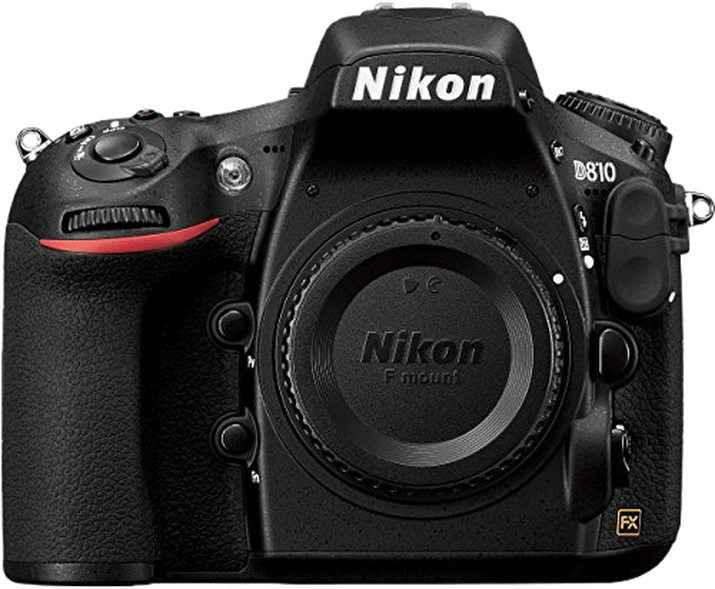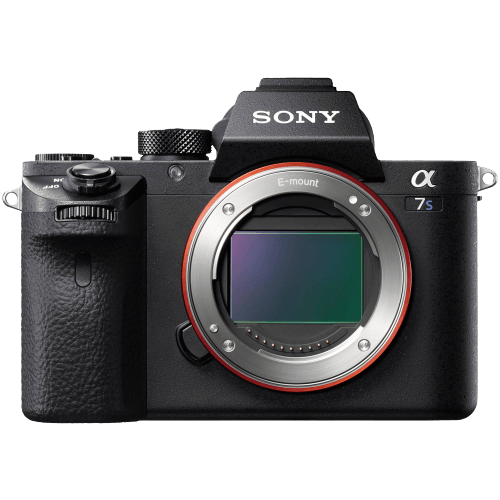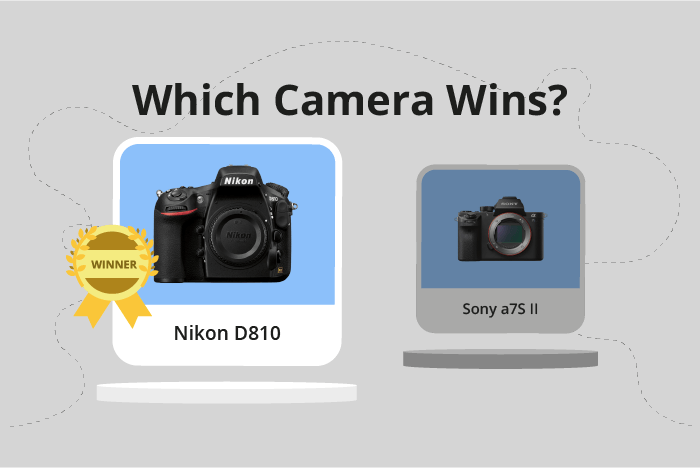Nikon D810 vs Sony a7S II Comparison
Nikon D810

Sony a7S II

The Nikon D810 outperforms the Sony a7S II with a score of 72/100 compared to 60/100. Both cameras share similarities, such as being released in the mid-2010s with the D810 in 2014 and the a7S II in 2015, and having a high launch price of $3300 and $3000, respectively.
The D810 excels with its DSLR camera type, larger size (146 x 123 x 82mm), and heavier weight (980g / 2.16lbs), providing a more professional feel. On the other hand, the a7S II has its merits as a mirrorless camera, boasting a more compact size (127 x 96 x 60mm) and lighter weight (627g / 1.38lbs), making it more portable and travel-friendly.
Taking these factors into account, the Nikon D810 is the superior option for those seeking a professional and sturdy camera, while the Sony a7S II caters to users who prefer a more compact and lightweight device.
Nikon D810 vs Sony a7S II Overview and Optics
The Nikon D810 outperforms the Sony a7S II in optics with a score of 76/100 compared to the Sony’s 66/100. Both cameras share several common specifications, such as a shooting speed of 5, a CMOS sensor type, and a full-frame sensor size. Additionally, both cameras use different lens mounts – the Nikon D810 with Nikon F FX and the Sony a7S II with Sony FE.
The Nikon D810 excels in several aspects, including a higher megapixel count of 36.3 compared to the Sony a7S II’s 12.2, resulting in more detailed images. The D810 also has a superior DXOMARK sensor score of 97, indicating better overall image quality. Moreover, the Nikon D810 is equipped with the Expeed 4 processor, which further contributes to its image quality.
On the other hand, the Sony a7S II has some advantages, such as built-in image stabilization, a feature absent in the Nikon D810. This allows for steadier shots and can help reduce camera shake, especially in low-light situations. The a7S II also uses the Bionz X processor, which, while not as powerful as the Expeed 4, still delivers good image quality.
Taking these factors into account, the Nikon D810 is the superior choice in terms of optics due to its higher megapixel count, better DXOMARK sensor score, and Expeed 4 processor. However, the Sony a7S II should not be overlooked, as its built-in image stabilization and Bionz X processor provide solid performance. Ultimately, the choice between these two cameras comes down to the individual’s priorities and preferences in terms of image quality and stabilization.
Nikon D810 vs Sony a7S II Video Performance
The Nikon D810 outperforms the Sony a7S II in video capabilities with a score of 70/100 compared to the Sony’s 56/100. Both cameras offer high-quality video recording, but there are key differences in their specifications that set them apart.
The Nikon D810 and Sony a7S II share some common video specifications. Both cameras have a maximum video resolution of Full HD (1920 x 1080), and each has built-in features for video recording. However, the similarities end there.
The Nikon D810 has a higher maximum video frame rate of 60fps, allowing for smoother video playback compared to the Sony a7S II, which has a maximum frame rate of 30fps. Additionally, the Nikon D810 has built-in time-lapse functionality, which the Sony a7S II lacks.
Despite its lower video score, the Sony a7S II does have an advantage in its 4K video resolution (3840 x 2160), offering four times the resolution of Full HD. This means that the Sony a7S II can capture more detail in its video recordings compared to the Nikon D810. However, this advantage is diminished by the lower maximum frame rate and the lack of time-lapse functionality.
Taking all of these factors into account, the Nikon D810 emerges as the superior choice for video capabilities due to its higher maximum frame rate and built-in time-lapse functionality. While the Sony a7S II does offer 4K video resolution, it falls short in other crucial areas. The Nikon D810 provides a more versatile and user-friendly video recording experience, making it the better option for those prioritizing video capabilities in their camera choice.
Nikon D810 vs Sony a7S II Features and Benefits
The Nikon D810 triumphs over the Sony a7S II in the features category with a score of 59 out of 100, compared to the Sony’s 57. Both cameras share several specifications, including the absence of a touchscreen, GPS, and Bluetooth. They also both offer Wi-Fi connectivity.
The Nikon D810 has a larger screen size of 3.2 inches, compared to the Sony a7S II’s 3 inches. Additionally, the D810’s screen resolution is slightly higher at 1,229,000 dots, versus the a7S II’s 1,228,800 dots. These factors contribute to the D810’s superior score in features.
On the other hand, the Sony a7S II does outshine the Nikon D810 in one aspect: it has a flip screen. This feature allows for more flexible shooting angles and can be particularly useful for capturing images and videos from challenging perspectives.
Taking these factors into account, the Nikon D810 secures its lead in the features category with its larger screen size and higher screen resolution, providing a better viewing experience for photographers. Meanwhile, the Sony a7S II’s flip screen gives it an edge in versatility. Ultimately, the choice between these two cameras will depend on the user’s specific needs and preferences, as each offers unique advantages in terms of features.
Nikon D810 vs Sony a7S II Storage and Battery
The Nikon D810 outperforms the Sony a7S II in storage and battery with a score of 79/100, compared to the Sony’s 21/100. Both cameras accept SD/SDHC/SDXC memory cards, but the Nikon D810 additionally supports Compact Flash and UDMA cards, and has two memory card slots, while the Sony a7S II has only one and accepts Memory Stick Duo/Pro Duo/Pro-HG Duo cards.
The Nikon D810’s battery life is significantly longer at 1200 shots, using the EN-EL15 battery, while the Sony a7S II’s battery life is limited to 370 shots with the NP-FW50 battery. Neither camera offers USB charging.
In terms of storage and battery, the Nikon D810 is the clear winner with its longer battery life, additional memory card slot, and wider range of supported memory cards. The Sony a7S II falls behind in this aspect, with a shorter battery life and fewer memory card options.
Nikon D810 vs Sony a7S II – Our Verdict
Are you still undecided about which camera is right for you? Have a look at these popular comparisons that feature the Nikon D810 or the Sony a7S II:

